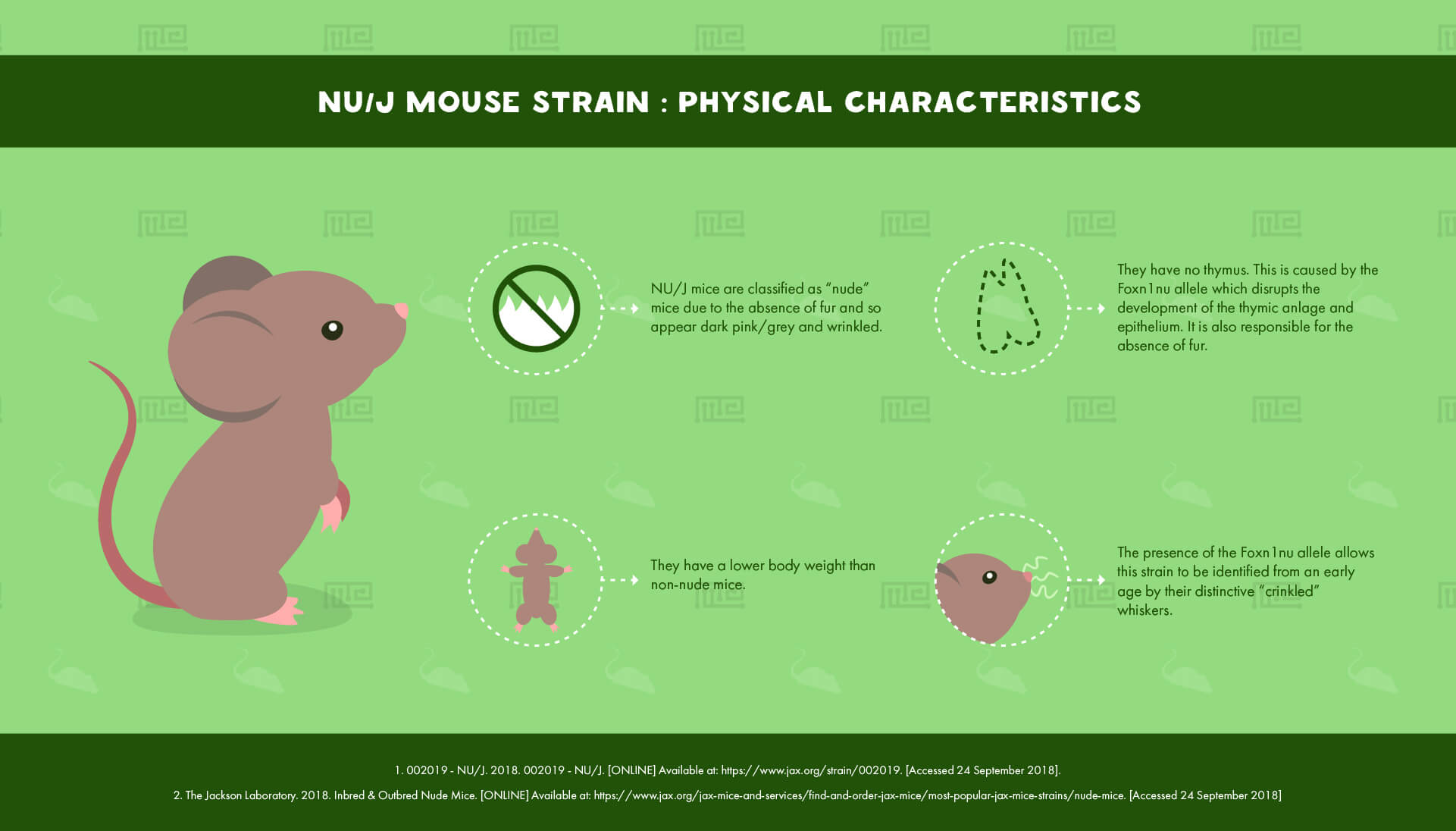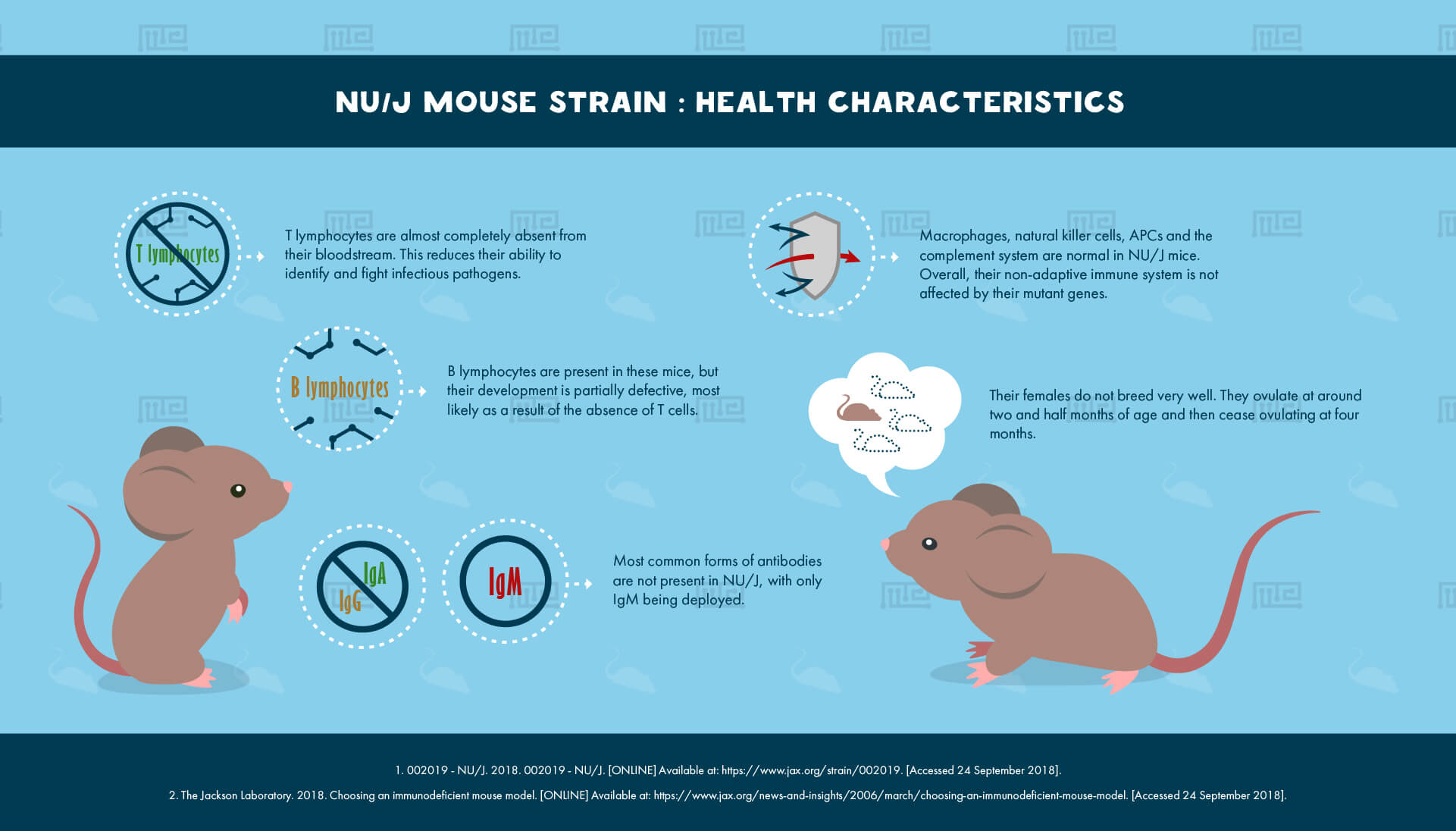Overview
NU/J, also known as nu/nu or athymic nude, is an inbred strain of nude mouse. It lacks a thymus and so has a severely compromised immune system, making it useful for immunological research.[1]
History
The earliest nude mice, from which NU/J is descended, arose in the early 1960s at Ruchill Hospital in Glasgow. Dr. Norman Grist noticed the striking phenotype of these mice, who had spontaneously acquired a mutation for hair loss and athymism.
A stock of these mice was acquired by the Jackson Laboratory from the NIH in 1975. These outbred mice were then inbred at the Jackson Laboratory for 100 generations to produce the current NU/J strain.[1]
Physical Characteristics
NU/J mice are classified as “nude” mice since they have no fur, and so appear dark pink/grey and wrinkled. They have a lower body weight than non-nude mice.[1][2]
They do not have a thymus, as a consequence of possessing the Foxn1nu allele, which disrupts the development of the thymic anlage and epithelium. This same allele is also responsible for their failure to grow fur. It also allows them to be identified from an early age by their distinctive “crinkled” whiskers.[1]
Behavioral Characteristics & Handling
Since nude mice are highly immune deficient, it is imperative to handle them under sterile conditions. Handling should be minimized, and when necessary should always be performed with gloves and a face mask to avoid infecting the mice.
These mice (which are homozygous for the pathological nu allele) show significantly lower locomotor activity and sociability in the open field test than euthymic mice heterozygous for the mutant allele. They also appear to exhibit slightly less anxiety in the light-dark box test.[3]
Health Characteristics
The absence of a thymus in NU/J mice severely affects the development of their immune system. T lymphocytes are almost completely absent from their bloodstream, reducing their ability to identify and fight infectious pathogens. Occasionally, a limited quantity of T cells can be detected, since the Foxn1nu mutation does not affect T cell precursors.[1][4]
B lymphocytes are present in these mice, but their development is partially defective, most likely as a result of the absence of T cells. Most common forms of antibodies are not present in NU/J, with only IgM being deployed.[1][4]
Macrophages, natural killer cells, APCs and the complement system are normal in NU/J mice. Overall, their non-adaptive immune system is not affected by their mutant genes.[4]
Female NU/J mice do not breed very well: they begin to ovulate at around two and half months of age and then cease ovulating when they reach four months.[1]
Major Experimental Uses
Mice of the NU/J strain offer a broad range of useful applications. Most prominently, they are applied to immunological research, especially research into immune deficiency disorders, autoimmunity and thymus defects. However, their immune deficiency is not severe enough to make them a good model for SCID.[1][3]
Sometimes researchers need to remove the thymus from mouse models for the purposes of experimentation. The absence of the thymus in this strain makes such procedures unnecessary and thus can prove highly convenient.[1]
Their highly muted immune response to alien tissue also makes them good subjects for xenografting experiments, such as tumor grafting experiments used in cancer research. Their issues with hair growth failure also mean they find a key place in dermatological research on skin and hair texture abnormalities.[1]
References
- 002019 – NU/J. 2018. 002019 – NU/J. [ONLINE] Available at: https://www.jax.org/strain/002019. [Accessed 24 September 2018].
- The Jackson Laboratory. 2018. Inbred & Outbred Nude Mice. [ONLINE] Available at: https://www.jax.org/jax-mice-and-services/find-and-order-jax-mice/most-popular-jax-mice-strains/nude-mice. [Accessed 24 September 2018].
- Jose Vidal. Differences of nu/ + and nu/nu Mice in Some Behaviors Reflecting Temperament Traits. 1996. Physiology & Behavior. Vol. 59. No. 2, pp. 341-348
- The Jackson Laboratory. 2018. Choosing an immunodeficient mouse model. [ONLINE] Available at: https://www.jax.org/news-and-insights/2006/march/choosing-an-immunodeficient-mouse-model. [Accessed 24 September 2018].


